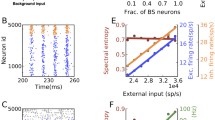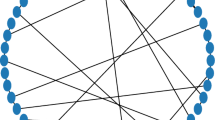Abstract
It was often reported and suggested that the synchronization of spikes can occur without changes in the firing rate. However, few theoretical studies have tested its mechanistic validity. In the present study, we investigate whether changes in synaptic weights can induce an independent modulation of synchrony while the firing rate remains constant. We study this question at the level of both single neurons and neuronal populations using network simulations of conductance based integrate-and-fire neurons. The network consists of a single layer that includes local excitatory and inhibitory recurrent connections, as well as long-range excitatory projections targeting both classes of neurons. Each neuron in the network receives external input consisting of uncorrelated Poisson spike trains. We find that increasing this external input leads to a linear increase of activity in the network, as well␣as an increase in the peak frequency of oscillation. In␣contrast, balanced changes of the synaptic weight of␣excitatory long-range projections for both classes of postsynaptic neurons modulate the degree of synchronization without altering the firing rate. These results demonstrate that, in a simple network, synchronization and firing rate can be modulated independently, and thus, may be used as independent coding dimensions.
Similar content being viewed by others
References
Abbott LF, Nelson SB (2000) Synaptic plasticity: taming the beast. Nat Neurosci 3:1178–1183
Abeles M (1982) Local cortical circuits. An electrophysiological study. Springer, Berlin
Artola A, Singer W (1987) Long-term potentiation and NMDA receptors in rat visual cortex. Nature 330:649–652
Bao S, Chan VT, Merzenich MM (2001) Cortical remodelling induced by activity of ventral tegmental dopamine neurons. Nature 412:79–83
Bao S, Chang EF, Woods J, Merzenich MM (2004) Temporal plasticity in the primary auditory cortex induced by operant perceptual learning. Nat Neurosci 7:974–981
Bedenbaugh P, Gerstein GL (1997). Multiunit normalized cross correlation differs from the average single-unit normalized correlation. Neural Comput 9(6):1265–1275
Brunel N, Hakim V (1999) Fast global oscillations in networks of integrate-and-fire neurons with low firing rates. Neural Comput 11(7):1621–1671
Brunel N, Wang XJ (2003) What determines the frequency of fast network oscillations with irregular neural discharges? I. Synaptic dynamics and excitation-inhibition balance. J Neurophysiol 90:415–430
Bush PC, Douglas RJ (1991) Synchronization of bursting action potential discharge in a model network of neocortical neurons. Neural Comp 3:19–30
Bush PC, Sejnowski TJ (1996) Inhibition synchronizes sparsely connected cortical neurons within and between columns in realistic network models. J Comp Neurosci 3:91–110
Buzsaki G, Eidelberg E (1983) Phase relations of hippocampal projection cells and interneurons to theta activity in the anesthetized rat. Brain Res 266:334–339
Buzsaki G, Leung LW, Vanderwolf CH (1983) Cellular bases of hippocampal EEG in the behaving rat. Brain Res 287:139–171
Crist RE, Li W, Gilbert CD (2001) Learning to see: experience and attention in primary visual cortex. Nat Neurosci 4:519–525
Csicsvari J, Hirase H, Czurko A, Mamiya A, Buzsaki G (1999) Oscillatory coupling of hippocampal pyramidal cells and interneurons in the behaving Rat. J Neurosci 19:274–287
Deadwyler SA, Hampson RE (1997) The significance of neural ensemble codes during behavior and cognition. Annu Rev Neurosci 20:217–244
Destexhe A, Rudolph M, Pare D (2003) The high-conductance state of neocortical neurons in␣vivo. Nat Rev Neurosci 4:739–751
Douglas RJ, Martin KA (2004) Neuronal circuits of the neocortex. Annu Rev Neurosci 27:419–451
Engel AK, Fries P, Singer W (2001) Dynamic predictions: oscillations and synchrony in top-down processing. Nat Rev Neurosci 10:704–716
Fourcaud-Trocmé N, Hansel D, van Vreeswijk C, Brunel N. (2003) How spike generation mechanisms determine neuronal response to fluctuating inputs. J Neurosci 23(37):11628–11640
Fries P, Reynolds JH, Rorie AE, Desimone R (2001a) Modulation of oscillatory neuronal synchronization by selective visual attention. Science 291:1560–1563
Fries P, Neuenschwander S, Engel AK, Goebel R, Singer W (2001b) Rapid feature selective neuronal synchronization through correlated latency shifting. Nat Neurosci 4:194–200
Fu YX, Djupsund K, Gao H, Hayden B, Shen K, Dan Y (2002) Temporal specificity in the cortical plasticity of visual space representation. Science 296:1999–2003
Gerstein GL (2000). Cross-correlation measures of unresolved multi-neuron recordings. J Neurosci Methods 100(1–2):41–51
Ghose GM, Yang T, Maunsell JH (2002) Physiological correlates of perceptual learning in monkey V1 and V2. J Neurophysiol 87:1867–1888
Golomb D, Hansel D (2000) The number of synaptic inputs and the synchrony of large, sparse neuronal networks. Neural Comput 12:1095–1139
Grammont F, Riehle A (2003) Spike synchronization and firing rate in a population of motor cortical neurons in relation to movement direction and reaction time. Biol Cybern 88:360–373
Gray CM, König P, Engel AK, Singer W (1989) Oscillatory responses in cat visual cortex exhibit inter-columnar synchronization which reflects global stimulus properties. Nature 338:334–337
Hansel D, Mato G (2003) Asynchronous states and the emergence of synchrony in large networks of interacting excitatory and inhibitory neurons. Neural Comput 15:1–56
Herculano-Houzel S, Munk MH, Neuenschwander S, Singer W (1999) Precisely synchronized oscillatory firing patterns require electroencephalographic activation. J Neurosci 19:3992–4010
Hines ML, Carnevale NT (1997) The NEURON simulation environment. Neural Comput 9:1179–1209
Jefferys JG, Traub RD, Whittington MA (1996) Neuronal networks for induced ‹40 Hz’ rhythms. Trends Neurosci 19:202–208
Kamondi A, Acsady L, Wang XJ, Buzsaki G (1998) Theta oscillations in somata and dendrites of hippocampal pyramidal cells in␣vivo: activity-dependent phase-precession of action potentials. Hippocampus 8:244–261
Kano M, Rexhausen U, Dreessen J, Konnerth A (1992) Synaptic excitation produces a long-lasting rebound potentiation of inhibitory synaptic signals in cerebellar Purkinje cells. Nature 356:601–604
Knoblauch K, Falchier A, Giroud P, Kennedy H (2006) Areas V1, V2, and V4 have fixed numbers of connections from each afferent area. 2006 Abstract Viewer/Itinerary planner: Atlanta: Society for Neuroscience
König P, Schillen TB (1991) Stimulus-dependent assembly formation of oscillatory responses: I. Synchronization. Neural Comput 3:155–166
König P, Engel AK, Singer W (1995) Relation between oscillatory activity and long-range synchronization in cat visual cortex. Proc Natl Acad Sci USA 92:290–294
Lapointe V, Morin F, Ratte S, Croce A, Conquet F, Lacaille JC (2004) Synapse-specific mGluR1-dependent long-term potentiation in interneurones regulates mouse hippocampal inhibition. J Physiol 555:125–135
Longstaff A (2000) Neuroscience. BIOS Scientific Publishers Ltd, Oxford (UK)
Maldonado PE, Friedman-Hill S, Gray CM (2000) Dynamics of striate cortical activity in the alert macaque: II. Fast time scale synchronization. Cereb Cortex 10(11):1117–1131
McCormick DA, Connors BW, Lighthall JW, Prince DA (1985) Comparative electrophysiology of pyramidal and sparsely spiny stellate neurons of the neocortex. J Neurophysiol 54:782–806
Milner PM (1974) A model for visual shape recognition. Psychol Rev 81:521–535
Munk MH, Roelfsema PR, König P, Engel AK, Singer W (1996) Role of reticular activation in the modulation of intracortical synchronization. Science 272:271–274
Neven H, Aertsen A (1992) Rate coherence and event coherence in the visual cortex: a neuronal model of object recognition. Biol Cybern 67:309–322
Palm G, Aertsen AM, Gerstein GL (1988) On the significance of correlations among neuronal spike trains. Biol Cybern 59:1–11
Perez Y, Morin F, Lacaille JC (2001) A hebbian form of long-term potentiation dependent on mGluR1a in hippocampal inhibitory interneurons. Proc Natl Acad Sci USA 98:9401–9406
Pfeuty B, Mato G, Golomb D, Hansel D (2005) The combined effects of inhibitory and electrical synapses in synchrony. Neural Comput 17:633–670
Recanzone GH, Merzenich MM, Jenkins WM, Grajski KA, Dinse HR (1992) Topographic reorganization of the hand representation in cortical area 3b owl monkeys trained in a frequency-discrimination task. J Neurophysiol 67:1031–1056
Recanzone GH, Schreiner CE, Merzenich MM (1993) Plasticity in the frequency representation of primary auditory cortex following discrimination training in adult owl monkeys. J Neurosci 13:87–103
Riehle A, Grun S, Diesmann M, Aertsen A (1997) Spike synchronization and rate modulation differentially involved in motor cortical function. Science 278:1950–1953
Ritz R, Sejnowski TJ (1997) Synchronous oscillatory activity in sensory systems: new vistas on mechanisms. Curr Opin Neurobiol 7:536–546
Salazar RF, König P, Heinzle J (2004a) Synchronization and firing rates as independent coding dimensions. 2004 Abstract Viewer/Itinerary planner. Society for Neuroscience, Washington D.C.
Salazar RF, Kayser C, König P (2004b) Effects of training on neuronal activity and interactions in primary and higher visual cortices in the alert cat. J Neurosci 24:1627–1636
Salinas E, Sejnowski TJ (2001) Correlated neuronal activity and the flow of neural information. Nat Rev Neurosci 2:539–550
Schoups A, Vogels R, Qian N, Orban G (2001) Practising orientation identification improves orientation coding in V1 neurons. Nature 412:549–553
Schuett S, Bonhoeffer T, Hubener M (2001) Pairing-induced changes of orientation maps in cat visual cortex. Neuron 32:325–337
Schwartz S, Maquet P, Frith C (2002) Neural correlates of perceptual learning: a functional MRI study of visual texture discrimination. Proc Natl Acad Sci USA 99:17137–17142
Singer W (1999) Neuronal synchrony: a versatile code for the definition of relations? Neuron 24:49–65, 111–125
Singer W, Gray CM (1995) Visual feature integration and the temporal correlation hypothesis. Annu Rev Neurosci 18:555–586
Softky WR, Koch C (1993) The highly irregular firing of cortical cells is inconsistent with temporal integration of random EPSPs. J Neurosci 13:334–350
Steinmetz PN, Roy A, Fitzgerald PJ, Hsiao SS, Johnson KO, Niebur E (2000) Attention modulates synchronized neuronal firing in primate somatosensory cortex. Nature 404:187–190
Sturm AK, König P (2001) Mechanisms to synchronize neuronal activity. Biol Cybern 84:153–172
Tiesinga PHE, Sejnowski TJ (2004) Rapid modulation of synchrony by competition in cortical interneuron networks. Neural Comput 16:251–275
Traub RD, Whittington MA, Stanford IM, Jefferys JG (1996) A mechanism for generation of long-range synchronous fast oscillations in the cortex. Nature 383:621–624
Tuckwell HC (1988) Introduction to theoretical neurobiology. Cambridge University Press, Cambridge
Turrigiano GG, Nelson SB (2004) Homeostatic plasticity in the developing nervous system. Nat Rev Neurosci 5:97–107
Vaadia E, Haalman I, Abeles M, Bergman H, Prut Y, Slovin H, Aertsen A (1995) Dynamics of neuronal interactions in monkey cortex in relation to behavioural events. Nature 373:515–518
von der Malsburg C (1981) The correlation theory of brain function. Internal report Max-Planck Institute for Biophysical Chemistry, Göttingen, West-Germany
von Stein A, Sarnthein J (2000) Different frequencies for different scales of cortical integration: from local gamma to long range alpha/theta synchronization. Int J Psychophysiol 38(3):301–313
Wang LY (2000) The dynamic range for gain control of NMDA receptor-mediated synaptic transmission at a single synapse. J Neurosci 20:RC115
Wang XJ, Buzsaki G (1996) Gamma oscillation by synaptic inhibition in a hippocampal interneuronal network model. J Neurosci 16:6402–6413
Yao H, Dan Y (2001) Stimulus timing-dependent plasticity in cortical processing of orientation. Neuron 32:315–323
Acknowledgements
This work was funded by the Swiss National Science Foundation (Grant Nr: 31-65415.01). We thank Kevan AC Martin, Charles M Gray, Stefano Fusi and Shih-Cheng Yen for their careful reading and critical comments on previous versions of the manuscript.
Author information
Authors and Affiliations
Corresponding author
Electronic supplementary material
Rights and permissions
About this article
Cite this article
Heinzle, J., König, P. & Salazar, R.F. Modulation of synchrony without changes in firing rates. Cogn Neurodyn 1, 225–235 (2007). https://doi.org/10.1007/s11571-007-9017-x
Received:
Accepted:
Published:
Issue Date:
DOI: https://doi.org/10.1007/s11571-007-9017-x




